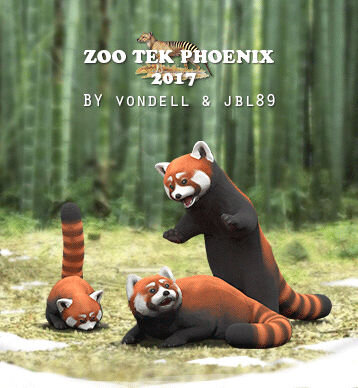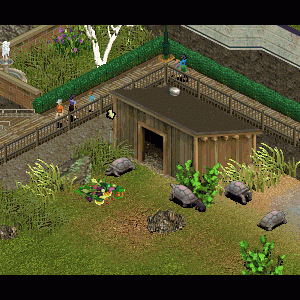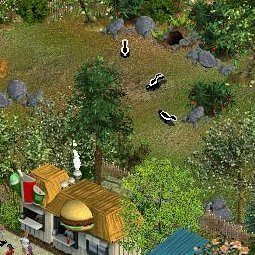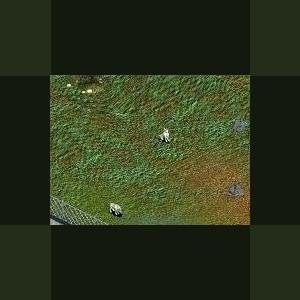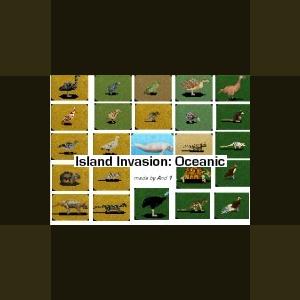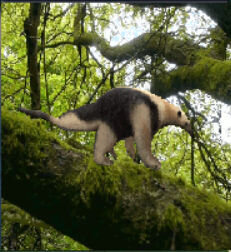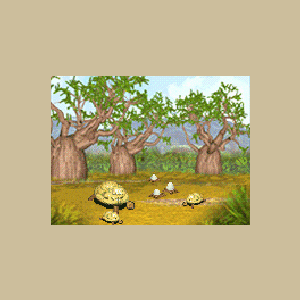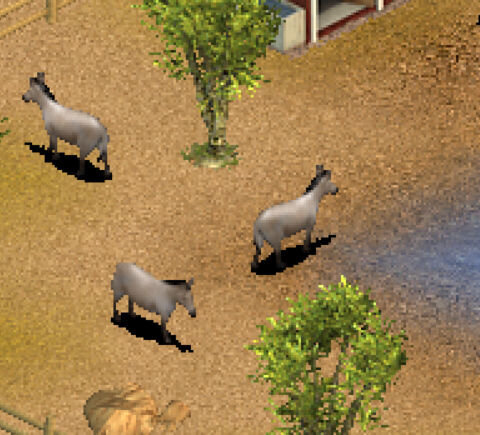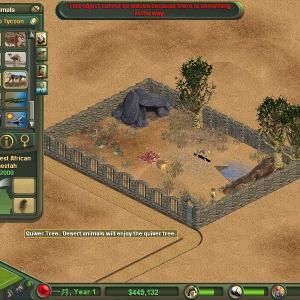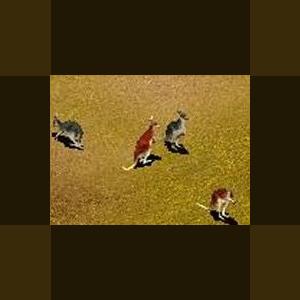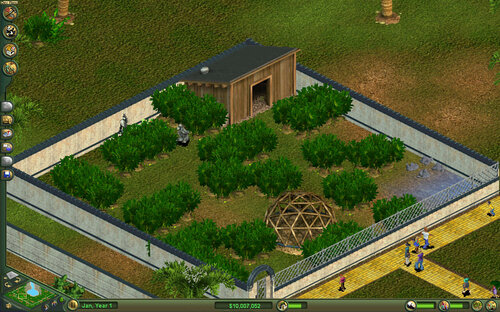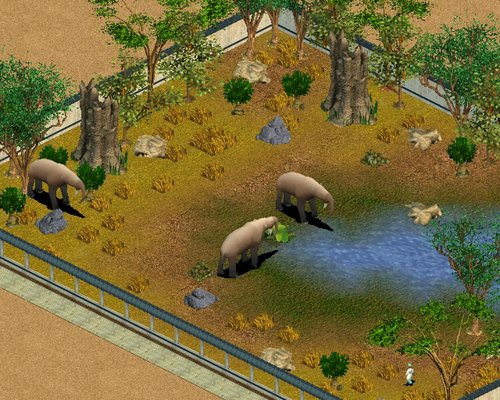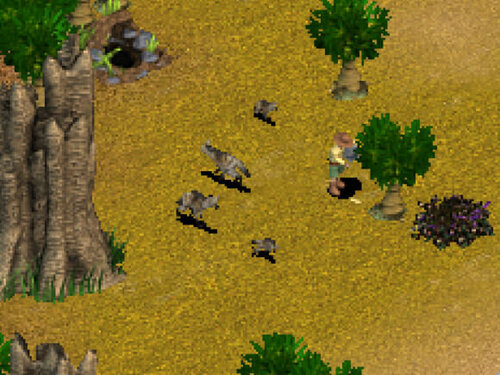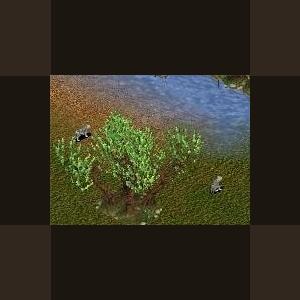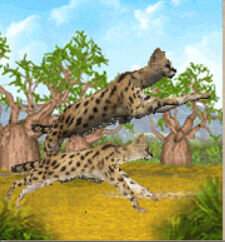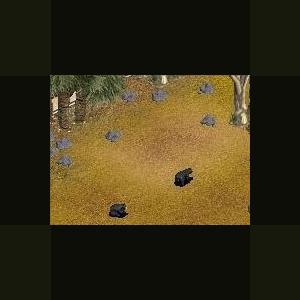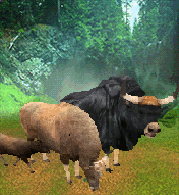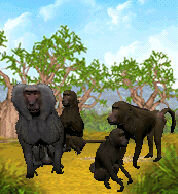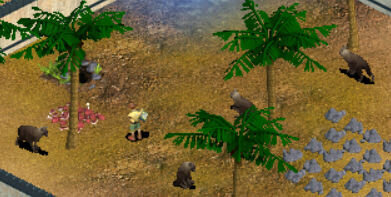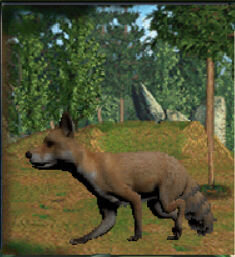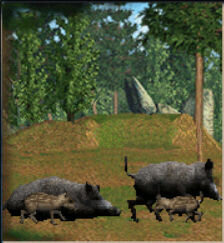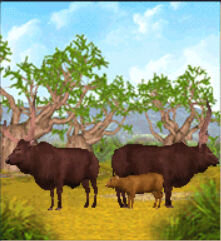279 files
-
White Rhinoceros by Khaydar
By Khaydar
Adopt a White Rhinoceros (Ceratotherium simum) for your zoos.
White Rhinoceros description:
Minimum happiness needed for chance of breeding: 90.
Liked foliage:
Thorn Bush, Umbrella Thorn Tree, Tall Grass
Liked rock:
Large Rock, Small Rock - Medium, Small Rock - Small
Number of animals allowed per exhibit: 1-10 with 50 squares each.
A suitable exhibit for 2 of this animal has 100 squares containing terrain of:
60 Savannah Grass, 10 Sand, 25 Dirt, 5 Fresh Water
using 9 grid squares filled with 4 Tall Grass most liked plant
and using 8 Small Rock - Small most liked rock.
Preferred shelter: Large Stable.
Credits to DutchDesigns for the model and mesh
Made by Khaydar
288 downloads
- living animal
- rhinoceros
- (and 1 more)
Updated
-
Red Panda by Vondell and JBL89
By jbl89
The Red Panda is an original new endangered animal, compatible with Zoo Tycoon 1 (no expansion packs needed).
You might also hear this little critter's unique cry once in a while.
From Wikipedia: The red panda (Ailurus fulgens), also called the lesser panda, the red bear-cat, and the red cat-bear, is a mammal native to the eastern Himalayas and southwestern China. It has reddish-brown fur, a long, shaggy tail, and a waddling gait due to its shorter front legs; it is slightly larger than a domestic cat. It is arboreal, feeds mainly on bamboo, but also eats eggs, birds, and insects. It is a solitary animal, mainly active from dusk to dawn, and is largely sedentary during the day.
- Design by Vondell
- Configuration by Jeff
(to admins: please test this animal once more, I'm using a slightly different version which was stable in my game. Vondell's been active for a bit, but I'm sure he's okay with publishing this first version of the Red Panda)
1,102 downloads
Updated
-
Aldabra Giant Tortoise by Vondell
By Cricket
Similar in size to the famous Galapagos giant tortoise but from the opposite side of the earth, the tortoises on the islands of the Aldabra Atoll in the Indian Ocean are some of the largest in the world.
Graphics and animations by Vondell.
Special thanks to Fern and Jay for file checks and assistance.
Please click on the picture to see the animations.
1,646 downloads
Updated
-
Skunk by msc3323
By Fern
Skunk by msc3323
Allowedly the Striped Skunk is not one of my best animals, but it can walk and stand. Here it is for your zoo-building pleasure :D
198 downloads
Updated
-
Westie by Jordan
By Guest
Westie by Jordan
The incredibly adorable West Highland White Terrier of Scotland. Dedicated to Paul and Snowy.
Updated 2010-11-11
Just to save space with less in zip and smaller image.
Nothing new.
170 downloads
Updated
-
Island Invasion Oceanic by And 1
By Guest
The Pack contains 24 animals of the Oceanic Area.
File is in english and german.
Animals included:
Sylviornis neocaledoniae (german: Du)
Numbat
Thorny Devil (german: Dornteufel)
Lace Monitor (german: Buntwaran)
Cape Barren Goose (german: Hühnergans)
Malleefowl (german: Thermometerhuhn)
Spinifex Pigeon (german: Rotschopftaube)
Lesser Bird of Paradise (german: Kleiner Paradiesvogel)
Adzebill (german: Aptornis)
King Island Emu (german: Schwarzer Emu)
Matschie's Tree-kangaroo (german: Matschie Baumkänguru)
South Island Goose (german: Südinsel Riesengans)
Common Wombat (german: Nacktnasenwombat)
Little Spotted Kiwi (german: Zwergkiwi)
Tiger Quoll (german: Riesenbeutelmarder)
Northern Cassowary (german: Einlappenkasuar)
Marsupial Lion (german: Beutellöwe)
Black-spotted Cuscus (german: Tüpfelkuskus)
Weka (german: Wekaralle)
Takahe
Quokka
Meiolania (german: Riesen Hornschildkröte)
Dugong
Western Long-beaked Echidna (german: Westlicher Langschnabeligel)
Updated 2010-11-03
Just to save space with less in zip and smaller image.
Nothing new.
2,060 downloads
Updated
-
Southern Anteater by Khaydar
By Khaydar
Adopt a Southern Anteater (Tamandua tetradactyla) for your zoos.
Southern Anteater description:
Cannot be used in original Zoo Tycoon: Requires DD
Minimum happiness needed for chance of breeding: 95.
Liked foliage:
Ulmo Tree, Llala Palm Tree, Kapok Tree
Animal can climb objects.
Animal can climb cliff.
Number of animals allowed per exhibit: 1-3 with 15 squares each.
A suitable exhibit for 2 of this animal has 30 squares containing terrain of:
24 Rainforest Floor, 2 Grass, 3 Dirt, 1 Fresh Water
using 4 grid squares filled with 4 Ulmo Tree most liked plant
and using no rocks.
Preferred shelter: Large Burrow.
Credits to Hendrix and Zerosvalmont for the model and mesh
Made by Khaydar
216 downloads
- living animal
- anteater
- (and 1 more)
Updated
-
Galapagos Tortoise ZTU Belgium
By Guest
The Galàpagos tortoise, or commonly known as the Giant tortoise: Two huge endangered species of tortoise found on the Aldabra Atoll in the Indian Ocean and on the Galápagos Islands off the coast of Ecuador in the Pacific. Both the Aldabran tortoise and the Galápagos tortoise, the latter made famous by Charles Darwin, can reach lengths in excess of 1 m (3½ ft) and weigh over 250 kg (551 lb). Reptiles of this size are likely to be very old, as growth is very slow; records exist of tortoises reaching 150 years of age.
The tortoise is now rare because of human slaughter of the animals, the destruction of its habitat, and the introduction of animals that feed on the young tortoises and compete for food with the adults. During the 19th century in particular, giant tortoises were heavily hunted by sailors, as a source of fresh meat, both while visiting islands and to take away on long voyages. The tortoises have been known to survive as long as 14 months without food or water. In the Galápagos the giant tortoises have evolved different shell, or carapace, shapes on the various islands.
This is a result of variations in habitat and the plants they eat. On those islands with limited food resources, smaller tortoises have evolved.
They have shells elevated above the neck and long legs which allow them to reach slightly higher vegetation. Two island forms are known to be extinct and a third is reduced to a single animal, "Lonesome George", the only remaining tortoise from Isla Pinta, who now resides at the Charles Darwin Research Station. Hope for the survival of giant tortoises relies upon continued worldwide protection and the success of the captive breeding programme instigated over 20 years ago at the Darwin station. Female tortoises lay up to 17 eggs in a 30-cm (12-in) hole and the young dig out on their own. Many captive-born tortoises have already been returned to the wild.
This was a unicum for ZTU. The first* animal from scratch, created by ZTU designer Jonathan is available here for download! This turtle will look great and your zoos although it has a little bug, it lays baby flamingo's instead of the baby turtles, I'm working on it now. Please bare with us.
Updated 2010-11-03
Just to save space with less in zip and smaller image.
Nothing new
518 downloads
Updated
-
African Wild Donkey
By Khaydar
Adopt the endangered African Wild Donkey (Equus africanus) for your zoos
Animal guide:
Minimum happiness needed for chance of breeding: 90.
Liked foliage:
Tall Grass, Umbrella Thorn Tree, Doum Palm Tree (NA)
Liked rock:
Large Rock, Small Rock - Medium, Small Rock - Small
Animal can jump.
Number of animals allowed per exhibit: 1-4 with 25 squares each.
A suitable exhibit for 2 of this animal has 50 squares containing terrain of:
29 Sand, 10 Savannah Grass, 8 Dirt, 3 Fresh Water
using 3 grid squares filled with 4 Doum Palm Tree (NA) most liked plant
and using 12 Small Rock - Small most liked rock.
Preferred shelter: Large Stable.
293 downloads
- living animal
- khaydars animal
- (and 1 more)
Updated
-
Northwest African Cheetah by RDingFT
By Fern
Northwest African Cheetah
Author : RDingFT
Compatibility : All Game Versions
Well I used the cheetah to create a new animal : Northwest African Cheetah :)
To reskin the cheetah, I used Markhor.pal.
The Northwest African Cheetah (Acinonyx jubatus hecki), also known as the Saharan Cheetah, is a subspecies of cheetah found in the northwestern part of Africa (particularly the central western Sahara desert and the Sahel). It is classified as critically endangered, with a total world population estimated to be about 250 mature individuals.
465 downloads
Updated
-
Dimorphic Red Kangaroo by Ghirin
By Guest
Dimorphic Red Kangaroo
Author: Ghirin
Red kangaroos are the world's largest marsupials. Despite the name, not all red kangaroos are red. In the eastern part of their range, males are usually some shade of red and females are blue-gray; elsewhere, both sexes may be reddish brown. Male kangaroos are called "boomers," female kangaroos are "blue fliers," and young are called "joeys." Red kangaroos are found primarily in the dry grasslands and plains of central Australia. The terrain in this region consists of savannah-like grasses interspersed with barren areas of dry dirt, sand, and the occasional rock. Kangaroos prefer open areas, with a sparse scattering of native bushes and trees for shade. Kangaroos are semi-nomadic, and their movements are not restricted by most types of fencing.
These animals congregate in loose and temporary social groupings, called mobs. Although the makeup of a mob can vary, it will commonly contain a dominant male, several adult females, and young of both sexes. Mothers and young can remain together for years.
Kangaroos are able to survive high temperatures by seeking shade during the day and feeding at night. In the wild, their diet consists of green grass, leaves, and roots. They swallow their food whole, later regurgitating a cud and chewing it. In the wild, this animal does not need continual access to fresh water, as long as green herbage is available. When necessary, they will dig for water. In zoos, kangaroos are fed a diet that typically includes fruit, yams, bread, monkey-dog-guinea pig chow, and vitamin supplements.
Baby kangaroos are bean-sized when born. The tiny, hairless embryo makes its way across the mother's belly into the pouch, where it attaches itself to one of the four available teats. Once nursing begins, the teat swells up so that the baby will remain attached. The joey will remain in the pouch for 5 to 6 months as it continues to mature. After that, it will be fully developed and can emerge to explore. Joeys are usually weaned around one year of age, but will remain close to the mother for another six months.
Kangaroos are so well-designed for hopping that they are unable to walk. They have large, powerful hind feet that cannot move independently of each other and a tendon in their legs that behaves like a rubber band, conserving energy as they move. Red kangaroos can hop as fast as 40 mph, making leaps as long as 29 feet. Kangaroos will run from danger, rather than fight, although a large claw attached to their hind leg makes them quite dangerous at close quarters. The kangaroo's long, heavy tail provides balance and support.
Red kangaroos are shy, alert creatures, docile except when cornered. To warn their mob of impending danger, these animals will thump on the ground. Hearing this warning, joeys will jump back into their mothers' pouches. Although males will not defend the members of their mob from attack, they will fight each other for breeding rights. The two boomers will attempt to push each other off balance by jabbing or locking forearms. Sometimes they will lean back on their tails and kick each other in the belly with their powerful hind feet.
Foxes and eagles prey on very young kangaroos. Dingoes prey on young and adult alike. Because of the damage they can do to crops, kangaroos are considered pests and are destroyed accordingly. Red kangaroos are also commercially hunted for skins and meat. This animal is considered a threatened species.
Updated 2010-10-30
Just to save space with less in zip and smaller image.
Nothing new.
341 downloads
Updated
-
Western Gorilla by Mjmannella
By mjmannella
This mod adds the Western gorilla (Gorilla gorilla) to your zoos. This was largely done to honour Kubi, a Western lowland gorilla who was a finalist in Microsoft's Beast in Show competition. Made by Mjmannella.
68 downloads
Updated
-
Deinotherium
By Khaydar
Adds the deinotherium for your zoos. Based on the species D.giganteum from the Miocene
Here's some data:
Number of animals:1-6
Animal compability:none (must be kept without other species)
Requires a mate: No
Needs toy: No
Exhibit size: 100 sq
Terrain: 40 savannah
20 rainforest
10 freshwater
30 dirt
for a 100 sq exhibit
Shelter: Both elephant shelters
Foliage: 25 sq
Rocks: 4 sq
Biomes: Compatible with deciduous, savannah and tropical foliage and rocks
Extra: Can also be kept with strong zoo tycoon fences for more realism.
Requires: Dinosaur Digs Expansion to work.
255 downloads
0 comments
Updated
-
Aardwolf by Khaydar
By Khaydar
Adopt an Aardwolf (Proteles cristata) for your zoos.
Animal guide:
Cannot be used in original Zoo Tycoon: Requires DD
Minimum happiness needed for chance of breeding: 90.
Liked foliage:
Acacia Caffra Tree, Thorn Bush and African savannah foliage
Liked rock:
Large Rock, Small Rock - Medium, Small Rock - Small
Animal can jump.
Number of animals allowed per exhibit: 1-2 with 20 squares each.
A suitable exhibit for 2 of this animal has 40 squares containing terrain of:
22 Savannah Grass, 8 Sand, 8 Dirt, 2 Fresh Water
using 4 grid squares filled with 4 Thorn Bush most liked plant
and using 8 Small Rock - Small most liked rock.
Preferred shelter: Large Burrow.
Updated: 18 January 2021 by fern to change the ztd and zip names (to avoid a file name conflict), and to compress the ztd better. None of the files inside the ztd were changed.
333 downloads
- living animal
- hyena
- (and 1 more)
Updated
-
Fishing Cat by Jordan
By Guest
The fishing cat is a small cat of Southeast Asia which lives along streams, rivers and swamps.
Updated 2010-11-03
Just to save space with less in zip and smaller image.
Nothing new
412 downloads
Updated
-
Serval
By Khaydar
Adopt a Serval ( Leptailurus serval) for your zoos.
Animal guide:
Minimum happiness needed for chance of breeding: 97.
Liked foliage:
Savannah foliage
Liked rock:
Large Rock, Small Rock - Medium, Small Rock - Small
Animal can jump.
Animal can climb cliff.
Number of animals allowed per exhibit:
1-2 with 18 squares each.
A suitable exhibit for 2 of this animal has 36 squares containing terrain of:
26 Savannah Grass, 4 Sand, 4 Dirt, 2 Fresh Water
using 6 grid squares filled with 4 Tall Grass most liked plant
and using 19 Small Rock - Small most liked rock.
Preferred shelter:
Large Burrow.
Other liked items:
Waterfall Rock
377 downloads
- living animal
- khaydars animal
- (and 1 more)
Updated
-
Tasmanian Devil by Jordan
By Guest
Tasmanian devils are fierce carnivorous marsupials that typically live alone.
Geographic Range
Currently Sarcophilus laniarius is found only in Tasmania, although fossil evidence suggests that it once occupied much of the Australian mainland. It has been suggested that its absence in many previously occupied areas can be explained by competition with the introduced dingo in Australia. (Nowak, 1991)
Habitat
Tasmanian devils are numerous throughout Tasmania except in areas where there has been extensive habitat fragmentation and deforestation. They are most numerous in coastal heath and rangeland areas where agricultural practices maintain a constant supply of carrion. They also occur in open, dry schlerophyll forest and mixed schlerophyll rainforest. Their dens typically are located in hollow logs, caves, or burrows. (DPIWE and Nature Conservation Branch, 2005; Nowak, 1991)
Physical Description
Mass
4 to 12 kg
(8.8 to 26.4 lbs)
Length
525 to 800 mm
(20.67 to 31.5 in)
Tasmanian devils are stocky with a brownish black pelage. They have a white throat patch, white spots on their sides and backside, and a pinkish snout. The head is massive with well developed jaw muscles. Molar teeth are heavy and adapted for their role in crushing bone and tearing through muscle and thick skin. Females are slightly smaller than males. Body size varies considerably with diet, habitat, and age. Large males may reach 12 kg and 30 cm at the shoulder. Total length ranges from 525 to 800 mm and tail length from 230-300 mm. Male weight ranges from 5.5 to 12 kg and female weight from 4.1 to 8.1 kg. Fat storage occurs in the tail, as in many dasyurids. Females have four mammae and, unlike many other dasyurids, the marsupial pouch is completely closed when breeding. (DPIWE and Nature Conservation Branch, 2005; Nowak, 1991)
Reproduction
Breeding interval
Tasmanian devils breed once yearly.
Breeding season
Tasmanian devils breed in April.
Number of offspring
4 (high); avg. 2-3
Gestation period
21 days (average)
Time to weaning
5 to 6 months
Time to independence
8 months (average)
Age at sexual or reproductive maturity (female)
2 years (average)
Males compete for access to breeding females. Females are only temporarily subdued by a male for mating, there is no longer term association of males and females. (DPIWE and Nature Conservation Branch, 2005)
Tasmanian devils are monestrous. Most mating takes place in March and the young are born in April after a gestation period of 21 days. Litter size is usually 2-3, although 4 mammae are available and 4 young are possible. The young then travel to the pouch where they remain for 4 months. By 5-6 months old the young are completely weaned, becoming independent in December. Females become sexually mature at two years old. (DPIWE and Nature Conservation Branch, 2005; Nowak, 1991)
Females nurse and protect their offspring in their pouch during most of their development. After weaning the young begin to disperse from their natal range. (DPIWE and Nature Conservation Branch, 2005; Nowak, 1991)
Lifespan/Longevity
Tasmanian devils most often live to a maximum of 5 years old in the wild. Most young die immediately after dispersing out of their natal range as a result of food scarcity or competition. They may live 7 to 8 years. (DPIWE and Nature Conservation Branch, 2005; Nowak, 1991)
Behavior
Tasmanian devils are nocturnal and usually solitary. Occasionally, when individuals congregate at food sources, such as carrion, they interact aggressively but they are not territorial. When fighting, Tasmanian devils vocalize with growls, screeches, and vibratos. There also seems to be a learned dominance hierarchy, at least in captive situations.
Both males and females make nests of bark, grass and leaves which they inhabit throughout the day. They may be seen sunbathing during the day in quiet areas. (DPIWE and Nature Conservation Branch, 2005; Nowak, 1991)
Home Range
Tasmanian devils stay within a relatively small home range, traveling an average of 3.2 km in a night. (Nowak, 1991)
Communication and Perception
Tasmanian devils have keen senses of smell, sight, touch, and taste. They communicate through a wide variety of vocalizations and physical cues, such as yawning and raising their tails. Tasmanian devils are regarded with some awe because of the blood-curdling shrieks and growls they use, particularly when a group is scavenging a carcass. (DPIWE and Nature Conservation Branch, 2005)
Food Habits
Tasmanian devils have been considered livestock predators. In reality, these marsupials take most of their large prey, such as wombats, wallabies, sheep, and rabbits, in the form of carrion. Tasmanian devils are efficient scavengers, eating even bones and fur. Tasmanian devils may have depended on carrion left from Tasmanian wolf kills in historical times. Other food items, such as insects, insect larvae, snakes, and small amounts of vegetation, are taken when encountered. Tasmanian devils forage in a slow, lumbering manner, using their sense of smell to find food at night. They are famous for their rowdy communal feeding, which is accompanied by aggression and loud vocalizations. (DPIWE and Nature Conservation Branch, 2005; Nowak, 1991)
Created by Jordan for Zoo Tek Phoenix
2008
Updated 2010-11-11
Just to save space with less in zip and smaller image.
Nothing new.
502 downloads
Updated
-
Gaur
By Khaydar
Adopt a Gaur (Bos frontalis) for your zoos.
Favorite plant: Rainforest fern
Shelter: Stable
Biome: Rainforest
278 downloads
- bovid
- khaydars animal
- (and 1 more)
Updated
-
Hamadryas Baboon
By Khaydar
Adopt an Hamadryas Baboon (Papio hamadryas) for your Zoos
Hamadryas Baboon description:
Minimum happiness needed for chance of breeding: 95.
Liked foliage:
Acacia Caffra Tree, Savannah foliage
Liked rock:
Large Rock, Small Rock - Medium, Small Rock - Small
Animal can jump.
Animal can climb objects.
Animal can climb cliff.
Number of animals allowed per exhibit: 3-20 with 15 squares each.
A suitable exhibit for 3 of this animal has 45 squares containing terrain of:
22 Savannah Grass, 9 Sand, 5 Dirt, 7 Brown Stone, 2 Fresh Water
using 5 grid squares filled with 4 Acacia Caffra Tree most liked plant
and using 25 Small Rock - Small most liked rock.
Preferred shelter: Large Concrete Shelter.
258 downloads
- khaydars animal
- living animal
- (and 1 more)
Updated
-
Brown Hyena by Khaydar
By Khaydar
Adopt a Brown Hyena (Hyaena brunnea) for your zoos.
Animal guide:
Minimum happiness needed for chance of breeding: 90.
Liked foliage:
Savannah foliage, desert foliage
Liked rock:
Savannah rocks, desert rocks, small, medium, large rocks
Animal can jump.
Number of animals allowed per exhibit: 2-8 with 20 squares each.
A suitable exhibit for 2 of this animal has 40 squares containing terrain of:
18 Sand, 8 Savannah Grass, 4 Dirt, 8 Brown Stone, 2 Fresh Water
using 2 grid squares filled with 4 Palm Tree most liked plant
and using 16 Small Rock - Small most liked rock.
Of the 40 squares, 1 nonadjacent squares should be elevated.
Preferred shelter: Large Burrow.
Updated: 19 January 2021 by fern to change the ztd and zip names (to avoid a file name conflict), and to compress the ztd better. None of the files inside the ztd were changed.
213 downloads
- living animal
- khaydars animal
- (and 1 more)
0 comments
Updated
-
Sumatran Rhinoceros by Khaydar
By Khaydar
Adopt a Sumatran Rhinoceros (Dicerorhinus sumatrensis) for your zoos.
Sumatran Rhinoceros description:
Minimum happiness needed for chance of breeding: 90.
Liked foliage:
Rainforest Fern, Mangrove Tree, Foxtail Palm Tree
Liked rock:
Large Rock, Small Rock - Medium, Small Rock - Small
Animal can climb objects.
Number of animals allowed per exhibit: 1-2 with 50 squares each.
A suitable exhibit for 2 of this animal has 100 squares containing terrain of:
80 Rainforest Floor, 5 Dirt, 10 Grass, 5 Fresh Water
using 19 grid squares filled with 4 Foxtail Palm Tree most liked plant
and using 8 Small Rock - Small most liked rock.
Preferred shelter: Large Stable.
Other liked items:
Waterfall Rock,
Credits to Eryel for the model and mesh
Made by Khaydar
168 downloads
- living animal
- rhinoceros
- (and 1 more)
Updated
-
Red Fox by Khaydar
By Khaydar
Adopt a Red Fox (Vulpes vulpes) for your zoos.
Red Fox description:
Minimum happiness needed for chance of breeding: 95.
Liked foliage:
Spruce Tree, Yellow Cedar Tree, Lodgepole Pine Tree, Maple Tree
Liked rock:
Large Rock, Small Rock - Medium, Small Rock - Small, Coniferous Forest Rock
Animal can jump.
Animal can climb cliff.
Number of animals allowed per exhibit: 1-3 with 35 squares each.
A suitable exhibit for 2 of this animal has 70 squares containing terrain of:
34 Deciduous Floor, 4 Fresh Water, 18 Grass, 14 Coniferous Floor
using 10 grid squares filled with 4 Spruce Tree most liked plant
and using 6 Small Rock - Small most liked rock.
Preferred shelter: Large Burrow.
Credits to Hendrix for the model and mesh
Made by Khaydar
247 downloads
- living animal
- canid
- (and 1 more)
Updated
-
Wild Boar by Khaydar
By Khaydar
Adopt a Wild Boar (Sus scrofa) to your zoos.
Wild Boar description:
Minimum happiness needed for chance of breeding: 90.
Liked foliage:
Weeping Willow Tree, White Oak Tree
Liked rock:
Large Rock, Small Rock - Medium, Small Rock - Small
Number of animals allowed per exhibit: 2-6 with 12 squares each.
A suitable exhibit for 2 of this animal has 24 squares containing terrain of:
11 Deciduous Floor, 2 Dirt, 1 Fresh Water, 4 Grass, 6 Coniferous Floor
using 10 grid squares filled with 4 Weeping Willow Tree most liked plant
and using 6 Small Rock - Small most liked rock.
Preferred shelter: Large Burrow.
Credits to Hendrix for the model and mesh
Made by Khaydar
223 downloads
- living animal
- pig
- (and 1 more)
0 comments
Updated
-
Watusi Cattle by Khaydar
By Khaydar
Adopt a Watusi (Bos taurus africanus) for your zoos.
Watusi description:
Minimum happiness needed for chance of breeding: 90.
Liked foliage:
Tall Grass, Savannah foliage
Animal can jump.
Number of animals allowed per exhibit: 4-15 with 20 squares each.
A suitable exhibit for 4 of this animal has 80 squares containing terrain of:
64 Savannah Grass, 8 Dirt, 8 Fresh Water
using 10 grid squares filled with 4 Tall Grass most liked plant
and 6 small rocks.
Preferred shelter: Large Stable.
Credits to DutchDesigns for the model and mesh
Made by Khaydar
165 downloads
- living animal
- bovid
- (and 1 more)
0 comments
Updated
-
Water Buffalo by Khaydar
By Khaydar
Adopt a Water Buffalo (Bubalus arnee) for your zoos.
Water Buffalo description:
Minimum happiness needed for chance of breeding: 90.
Liked foliage:
Rainforest Fern, Mangrove Tree
Liked rock:
Large Rock, Small Rock - Medium, Small Rock - Small
Animal can jump.
Number of animals allowed per exhibit: 3-15 with 20 squares each.
A suitable exhibit for 3 of this animal has 60 squares containing terrain of:
24 Rainforest Floor, 12 Dirt, 12 Grass, 12 Fresh Water
using 7 grid squares filled with 4 Mangrove Tree most liked plant
and using 5 Small Rock - Small most liked rock.
Preferred shelter: Large Stable.
Credits to DutchDesigns for the model
Made by Khaydar
184 downloads
- living animal
- bovid
- (and 1 more)
0 comments
Updated

